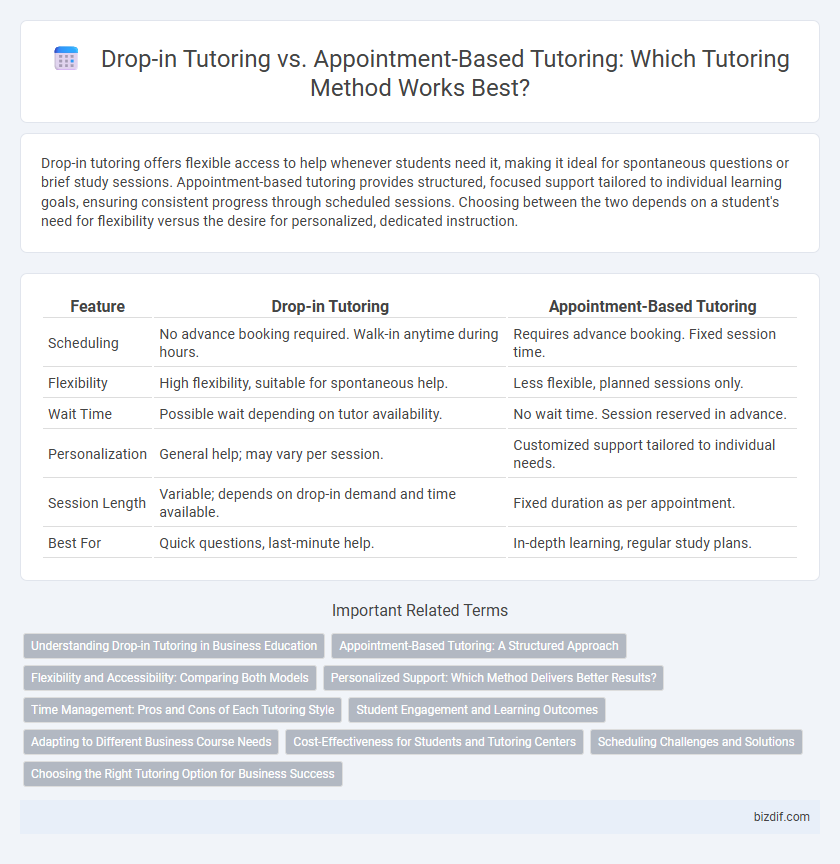Drop-in tutoring offers flexible access to help whenever students need it, making it ideal for spontaneous questions or brief study sessions. Appointment-based tutoring provides structured, focused support tailored to individual learning goals, ensuring consistent progress through scheduled sessions. Choosing between the two depends on a student's need for flexibility versus the desire for personalized, dedicated instruction.
Table of Comparison
| Feature | Drop-in Tutoring | Appointment-Based Tutoring |
|---|---|---|
| Scheduling | No advance booking required. Walk-in anytime during hours. | Requires advance booking. Fixed session time. |
| Flexibility | High flexibility, suitable for spontaneous help. | Less flexible, planned sessions only. |
| Wait Time | Possible wait depending on tutor availability. | No wait time. Session reserved in advance. |
| Personalization | General help; may vary per session. | Customized support tailored to individual needs. |
| Session Length | Variable; depends on drop-in demand and time available. | Fixed duration as per appointment. |
| Best For | Quick questions, last-minute help. | In-depth learning, regular study plans. |
Understanding Drop-in Tutoring in Business Education
Drop-in tutoring in business education offers flexible, immediate support for students seeking help with subjects like accounting, marketing, or finance without prior scheduling. This model encourages spontaneous learning and quick problem-solving, benefiting students with unpredictable schedules or urgent questions. Drop-in sessions optimize resource use by addressing diverse topics based on real-time demand, enhancing overall academic achievement in business courses.
Appointment-Based Tutoring: A Structured Approach
Appointment-based tutoring offers a structured approach that enhances personalized learning by allowing tutors to prepare tailored lesson plans based on individual student needs. This method ensures consistent progress tracking and targeted skill development, promoting in-depth understanding of complex subjects. Students receive dedicated time slots, which minimizes distractions and fosters a focused, goal-oriented tutoring environment.
Flexibility and Accessibility: Comparing Both Models
Drop-in tutoring offers maximum flexibility, allowing students to seek help on demand without prior scheduling, making it ideal for spontaneous queries and last-minute exam preparation. Appointment-based tutoring provides structured, dedicated sessions that ensure focused attention and tailored lesson plans, benefiting students who require consistent support. Both models enhance accessibility, with drop-in catering to immediate needs and appointments supporting long-term academic growth.
Personalized Support: Which Method Delivers Better Results?
Personalized support in appointment-based tutoring often delivers better results due to tailored lesson plans that address individual learning gaps and goals. Drop-in tutoring offers flexibility but may lack the consistent attention needed for deep comprehension and skill development. Studies show students with regular, scheduled sessions demonstrate higher engagement and improved academic performance compared to those relying on sporadic drop-in help.
Time Management: Pros and Cons of Each Tutoring Style
Drop-in tutoring offers flexible access, allowing students to seek help as needed without prior scheduling, which benefits those with unpredictable schedules but may lead to longer wait times during peak hours. Appointment-based tutoring ensures dedicated, uninterrupted sessions tailored to individual needs, promoting efficient use of time but requiring advanced planning that can be inconvenient for spontaneous learners. Both methods impact time management differently: drop-in prioritizes accessibility and adaptability, while appointment-based emphasizes structure and personalized focus.
Student Engagement and Learning Outcomes
Drop-in tutoring offers flexible, immediate support that can boost student engagement through on-demand assistance, catering to spontaneous learning needs. Appointment-based tutoring provides structured, personalized sessions that enhance learning outcomes by allowing tutors to tailor instruction to individual student goals and track progress over time. By balancing accessibility with customization, students can maximize both engagement and academic achievement.
Adapting to Different Business Course Needs
Drop-in tutoring offers flexible, on-demand support ideal for students needing immediate assistance with business course topics like finance or marketing, effectively addressing spontaneous questions and study challenges. Appointment-based tutoring provides structured, in-depth sessions tailored to complex subjects such as accounting principles or business analytics, allowing tutors to prepare customized materials aligned with specific course objectives. Adapting tutoring formats to the diverse demands of business curricula ensures optimal student engagement and mastery of critical concepts.
Cost-Effectiveness for Students and Tutoring Centers
Drop-in tutoring offers flexible, on-demand support that reduces administrative overhead and maximizes resource utilization, making it a cost-effective choice for both students and tutoring centers. Appointment-based tutoring, while potentially more structured and personalized, often entails higher scheduling and staffing costs that can increase expenses for providers and fees for students. Balancing these models allows tutoring centers to optimize operational efficiency and deliver affordable educational assistance tailored to diverse student needs.
Scheduling Challenges and Solutions
Drop-in tutoring offers flexible access without prior scheduling, accommodating unpredictable student needs but often resulting in wait times and limited tutor availability during peak hours. Appointment-based tutoring ensures dedicated, focused sessions by reserving time slots in advance, reducing conflicts and improving consistency in learning support. Implementing hybrid models with online scheduling platforms optimizes resource allocation and enhances student satisfaction by balancing flexibility and reliability.
Choosing the Right Tutoring Option for Business Success
Drop-in tutoring offers flexible, immediate support ideal for businesses requiring quick skill refreshers or on-demand problem-solving, while appointment-based tutoring provides structured, personalized sessions tailored to specific learning objectives and long-term development. Evaluating the company's workflow and employee learning preferences helps determine whether intermittent access or scheduled, in-depth guidance better drives performance improvements and ROI. Prioritizing the right tutoring format enhances talent development strategies and maximizes business impact through optimized knowledge acquisition.
Drop-in Tutoring vs Appointment-Based Tutoring Infographic

 bizdif.com
bizdif.com